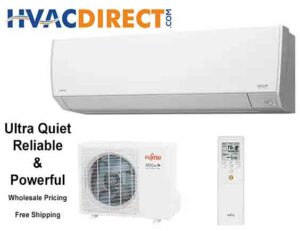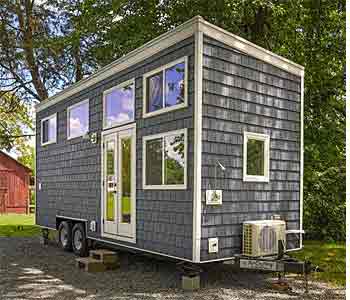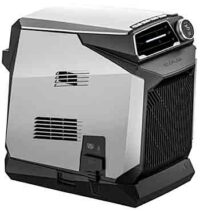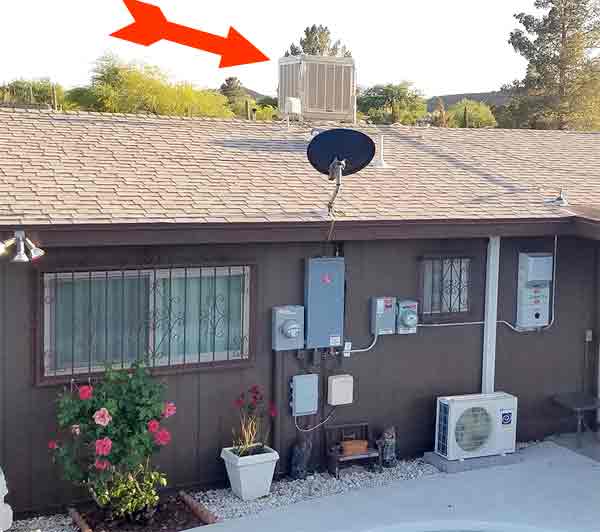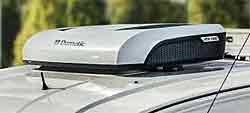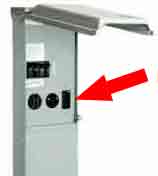Best Air Conditioners for RV’s and Tiny Houses
Whether you are planning new construction or augmenting existing equipment you need advice on the best air conditioner for your use. So, we did the leg work for you and came up with this list of the best air conditioners for RV’s and tiny houses.
Cooling power has been expressed in different ways over the years. One way was tons. Not 2000 lbs but how the amount of heat needed to melt 1 ton of ice in a 24 hour period. which is equivalent to 12,000 BTU (British Thermal Units) per hour. The higher the BTU the more the cooling power. Confused yet? I mention this because I just saw an ad on Facebook® for a “brand new” type of AC that put out 27 KW (Kilowatt). I’m not even going there.
A new rating system called SEER ( seasonal energy efficiency rating) indicates the efficiency of the air conditioner averaged over a season. The higher the SEER rating the more efficient the unit is. A SEER rating of 17 or better is ideal but can be expensive. If affordability is more important a SEER rating of 14 or 15 is ideal. To offset the extra expense of the higher rated units you realize cost saving on your energy bill.
For a real stand out see the RV roof air conditioner at the bottom of this page.
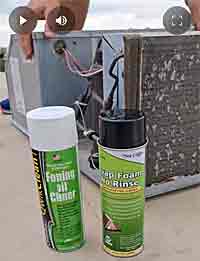
There are several types of air conditioners:
- Heat Pumps
- Ductless Mini Splits
- Central Air Conditioners
- Portable Air Conditioners
- Window Air Conditioners
- Evaporative Coolers
- RV Specific and Unique Air Conditioners
There are many different types of air conditioners. Each type has specific uses in mind when designed. A Central Air Conditioner requires ducting to get the cool air where it’s needed. Sometimes it can be tapped into existing central heating system ducts. If no ducts exist a Ductless Mini Split would be a better choice. To avoid costly installation charges many opt for a portable air conditioner then live with a large unit in their room or taking up a window.
What Size AC Do You Need
Air conditioners create cold air in pre-designed volumes called BTU’s (British Thermal Units). Use this chart to determine what size air conditioner you will need for your home or room.
Heat Pumps
Heat pumps are a type of air conditioner. They are more efficient because they use electricity to move heat from one place to another providing both heat or cool air when needed. The Ductless Mini Split shown here is a type of heat pump. Because of it’s efficiency it might qualify for rebates from various agencies and power companies.
To see more about efficiently keeping your tiny house or RV cooler in the summer including the use of earth tubes visit this page: Keeping Your Tiny Home Cooler in the Summer
Ductless Mini Splits
Note: Many air conditioners are being redesigned to use newer, more ecologically safe refrigerants at this time.
Because of that some of the links on this page will take you to alternate brands and similarly the same features for now.
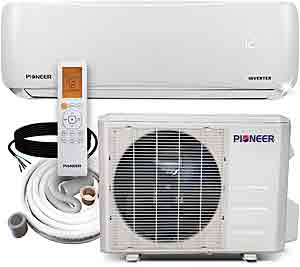
Ductless Mini Splits have many advantages especially after your tiny house build is complete. They can still be easily installed with the inside unit in the room you want and the outside unit mounted where it’s convenient.
Our favorite dustless mini split is the Pioneer, WYS012A-22. Both the inside and outside units are very quiet (inside just 24 db). It produces 12K BTU and runs on 110 volts AC. You should provide a dedicated circuit but doesn’t need 220 volts. It uses just 7 to 10 amps. This size is recommended for 300-500 Sqf.
With a Pioneer ductless mini split type air conditioning system, it is possible to heat or cool any contiguous area, quietly, effectively and efficiently. Pioneer brand WYS series ductless split heat pump systems come in a range of capacities; from 9000 BTU/hour to 36000 BTU/hour. Ways is an Inverter system with variable speed compressor, providing very high efficiency levels. Included wireless remote digital controller allows the users easily select among the 4 operating modes; cooling, heating, dehumidification and ventilation.
Featuring a DC inverter-driven compressor and fan motor, the Pioneer outside condenser units utilize the most efficient technology on the market, helping you cut down on your costly electricity bill. Comes with every needed component in the box, including an easy-install 16ft copper piping kit.
The cost on Amazon at the time I wrote this was $799.00* It has a SEER rating of 20! My local power company offers $350.00 in rebates for installing this in my tiny house.
Multi Zone Mini Split Air Conditioners
You can get mini-split air conditioners with more indoor units like two or three to cool different spaces. Installing in a long school bus, for instance, you might want one indoor unit in the master bedroom at the back of the bus and on in the central living area towards the center of the bus.
Install video
Here’s a good YouTube® video showing the install a Pioneer mini-split air conditioner into a skoolie.
Fujitsu Mini-Split, Heat Pumps
Fujitsu is a leader in mini-split engineering and functionality. After repeated breakdowns with a different brand the folks at Tiny Digs tiny house resort won’t use any other type than the Fujitsu mini split heat pump. See our video tour of Tiny Digs Lakeshore and notice how quiet these are while we’re filming right next to the unit. Whisper quiet.
Inverter technology is like cruise control for your heating or cooling system. Compressors only run as fast as they need to handle the cooling or heating demand. They can handle greater extremes in temperature, are smoother and more stable in operation, and reach the desired temperature more quickly than conventional air conditioners.
The 15,000 BTU Mini-Split heat pump shown here is quite capable of cooling the typical tiny house and poorly insulated RV even in the hottest temps. For two rooms there’s no need to install two of these. Design your own two room, Dual-zone heat pump.
The Fujitsu Dual Zone Mini Split Systems are state of the art ductless mini split heat pump systems, providing both heating and cooling for your home. Max SEER of 21.5, with an inverter-driven compressor, this efficient system will keep operating costs down while providing year-round comfort. Each living space has its own air-handling unit and each unit has its own wireless electronic temperature controller. With the Fujitsu Ductless Mini Split AOU18RLXFZ Heat Pump Air Conditioner Multi zone condenser each room or zone operates independently with its own wireless or wired remote controller so people in different rooms can choose the temperature that makes them most comfortable.
Ductless Mini-Split Pro’s and Con’s
The Pioneer Ductless Mini Split air conditioners are very efficient and quiet. But, they need to be installed and you may need professional help. With the Mini Spit kit shown you have the 16′ piping kit but the lineset and cable can be customized to 10, 25, 33, or 50 ft as needed.
The outside units can be installed almost anywhere with heavy duty mounting brackets. They do need to be kept clean, however.
A separate AC outlet will be needed for both inside and outside units.
See my favorite air conditioners on my Amazon Store here.
Central Air Conditioners
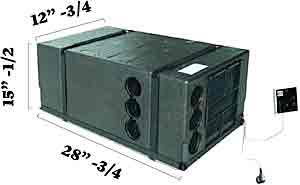
The Pioneer Under Bench RV Heat Pump/Air-Conditioner is a great example of a central air conditioned sized for an RV or tiny house. It uses 110 volts and creates 9000 BTU of cooling or heating.
Because it need ducts to get the air where you want it it is something you need to think about before building your tiny home or converting your Ram Promaster.
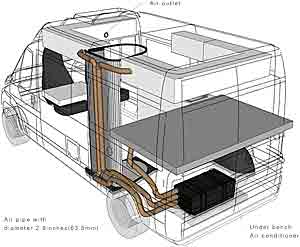 Envisioned to fit under a bench seat of an RV dinette the unit can be buried anywhere and the air ducted throughout the cabin of your RV or tiny home.
Envisioned to fit under a bench seat of an RV dinette the unit can be buried anywhere and the air ducted throughout the cabin of your RV or tiny home.
It’s really quiet, just 39 db and very efficient using 110 volts drawing only 985 watts. Here’s what Pioneer says: “Explore the great open road with Pioneer’s newest RV heat pump air conditioner.
Intended for under-the-bench installations, this low-profile and highly durable package system will keep your motor vehicle or tiny house at a cozy temperature all year round, and do so quietly.
Easily attach three ducts to serve separate areas of the dwelling, with options to connect to the front or side of the system. Control the system using the wall-fixed thermostat, or from the comfort of your bed using the convenient handheld remote controller.”
Check availability as this model comes and goes.
Portable Air Conditioners

Portable air conditioners are a practical option for tiny homes and RV’s. They are inexpensive for the amount of cooling they produce but only cool the room they are in. They can be rolled from room to room but they do take up floor space and the exhaust hose needs to be vented out a window or other opening.
The Black and Decker portable air conditioner unit shown is by far the most popular on Amazon. It quickly cools 450 sq.ft. and includes the window exhaust kit. It even has a remote control. The 10,000 BTU air conditioner is $309.99.* There are several larger sizes too. The 14,000 BTU unit will cool up to 700 sq. ft. They weigh around 50 lbs. but move easily on the casters. Two of the Black and Decker models also have heating capabilities for the winter.
Battery Operated Portable Air Conditioners
There are two real air conditioners that are battery operated, the ZeroBreeze, and EcoFlow Wave. These battery operated beauties pump out around 5200 BTU for about 5 hours.
A battery operated portable air conditioner is great for camping as you can use them in tents where there is no electric. They are also perfect for cooling one room of a small tiny home or a campervan. You can plug them in of course, charge them from your car while driving, and charge them from solar panels.
Many folks use then to augment the AC in a room that’s just not getting cool enough on a hot sunny day or a personal AC to help them sleep at night. You can put these light weight personal air conditioners on a table or night stand and direct the cool air right over yourself. They include clip on mounts and hoses for this purpose.
See more details about them on this page: Keeping Your RV Cool This Summer
Window Air Conditioners
Window air conditioners have been around forever. They were designed to fit in a “sash” window opening and plug in to the average AC outlet.
The model shown is a Midea U-Shaped, Smart Inverter 12,000 BTU window AC that sells for $377.98* (MSRP is $479.99) and is by far the most popular seller on Amazon with the most positive reviews. It requires 10 amps and creates only 32 dba noise operating at full blast. It is the first window AC to obtain the ENERGY STAR Most Efficient Certification
U Shaped Window Air Conditioner
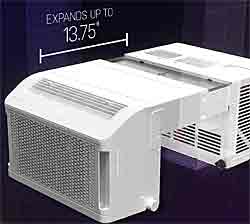
The U-Shape is a relatively new idea in window air conditioners. The U-shape allows you to get a lot more light from your window while keeping the noisy part of the unit outside. The distance between the two units is adjustable to fit any size wall. It’s easy to install because it drapes over the wall instead of dangling out the window. No mounting brackets are needed.
The GE ClearView 10.300 BTU smart inverter window air conditioner cools large rooms up to 450 square feet. It’s available in four sizes all plug in to a standard AC outlet for power.
Adaptive air conditioner inverter technology operates at smooth, varying levels, reducing noise and maximizing energy efficiency. At 34% more efficient, you can save energy without sacrificing performance. The Seer rating is 21. It’s also very quiet, just 40 db.
Evaporative Coolers
Evaporative coolers, also known as swamp coolers, work by pulling in fresh outside air through moist pads, where it is cooled by evaporation and circulated through the house by a large blower. These coolers typically are used where the air is hot and humidity low.
Our neighbor had one and it really cooled the house down nicely. We live in Colorado which can be very hot and dry so it worked well.
They need a water source and a power source. Their cool air port use most often cut right through the roof of the home. Because the cooling is done by evaporating water they add humidity to the home.
In the winter the unit is drained of all water and covered. Evaporative coolers need a major cleaning every season, and may need routine maintenance several times during the cooling season.
In this picture you can also see the outside unit of a mini-split which might mean that the evaporative cooler wasn’t sufficient enough cooling for them.
Indoor Swamp Coolers
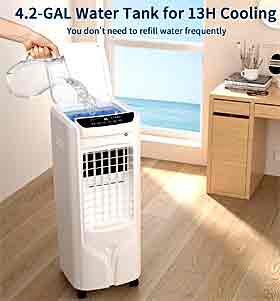 Indoor swamp coolers like this Uthfy, 5.3 gallon evaporative air cooler do emit cool air under the right conditions.
Indoor swamp coolers like this Uthfy, 5.3 gallon evaporative air cooler do emit cool air under the right conditions.
With the one we had the instruction said to leave a hot air source like a window open behind it for best results. The water needed to be refiled about every 30 minutes.
The model shown here has a 5.3 gallon water reservoir which they claim will provide 13 hours of cooling.
They include 4 ice packs that you can set in the water reservoir in an attempt to make it colder.
Because of the amount of moisture they add to the structure I do not recommend these for use in RV’s or tiny homes. Small homes already have issues with too much moisture. For more on that visit these page of the Tiny Life Consulting website: Dealing with Moisture in an RV and Tiny Home Moisture Complaints.
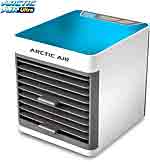
Arctic Air Pure Chill 2.0 Evaporative Air Cooler
The Arctic Air Cooler is a joke and does not work. It may be attractively priced but it will not save you from the summer heat. Do not buy it. I only mention evaporative swamp coolers because desperate people ask about them so you need to know.
RV Specific and Unique Air Conditioners
When you need the best the Furrion Chill RV roof air conditioner is the best choice for your RV. It’s super efficient and really quiet. The SEER rating is 40!
Shown at the top of the page the streamlined, aerodynamic design resists air drag and cuts down on fuel costs. It produces a remarkable 13.5K BTU of cooling. This RV air conditioner has 50% higher cooling capacity and 40% more energy efficiency compared to industry standards. It is also 50% quieter than single-fan models.
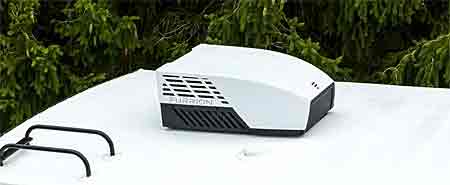
It weighs 93.4 lbs which might sound like a lot but is way less than your basic roof mounted RV air conditioner. Requiring 110 volts AC and just 11.2 amps.
Another thing you never think about when buying a new RV roof air conditioner is the cover. The cover on this air conditioner is very heavy duty and wont dry or crack after years in the sun. It is designed to keep the AC parts inside cool and clean.
The cost shown on Amazon today is $867.05* but you also must buy the inside part of it called the air distribution box for $105.50*, a thermostat, and a “controller” for $75.49.* There is a conversion kit if you want to use the air distribution box from you old AC unit. These pieces are sold separately so you can configure the installation many different ways to fit your needs. A single zone package is available for $1,117.95.* You can also add heating capability.
12 Volt Tiny Air Conditioner
A 12 volt air conditioner can plug directly into your12 volt battery system. There’s no need for an expensive inverter to transform the voltage up to 110 volts AC just for the guts of the air conditioner to transform the power back down to the 12 volts it needed in the first place. This makes a 12 volt AC more efficient.
This Dometic Air Conditioner is low profile. Originally designed for semi trucks to cool the cab without the engine running it’s perfect for converted camper vans or a campulance. It weighs 72 lbs. and measures ( W x H x D ) 34” x 12” x 25” (above the roof). Required cutout 15″ x 14″. · Electrical consumption: 19A-58A@12VDC . Operating on 12 volts means you don’t need to plug in to shore power or run thru a huge inverter. It will run for 12 hours on a 180 AH battery (in Eco mode). It produces 6824 BTU of cooling power. Remarkably it uses only 8 to 9.5 amps (in Eco mode).
All of this is possible thanks to the use of a variable speed inverter compressor, which makes for excellent cooling performance and amazingly efficient and quiet operation. It’s pricey though. On top of the initial $2,399.00 it requires an installation kit and a wiring kit. Click on image to learn more.
12 Volt Mini-Split
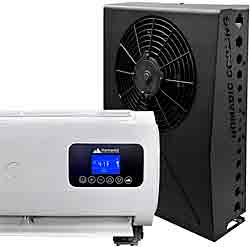
This unique 12 volt or 24 volt mini split air conditioner was designed with the Nomad in mind. These are perfect for a campervan because you can install the inside unit in the rear of the RV where you sleep and it is very quiet. The outside unit can be mounted on the rear door leaving the entire roof available for a roof rack or solar panels.
The Nomadic Cooling S1 12V Mini Split Camper Van Air Conditioner packs a punch with a cooling capacity of 11,280 BTU for the 24V and 9,600 BTU for the 12V system, swiftly bringing down the temperature to create an oasis even in the peak of summer heat.
This unit sells for $1,999.00. That’s pricey but it’s built to last.
Less Expensive Alternatives
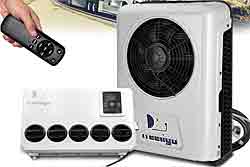
Amazon sells many less expensive alternative. Originally designed for semi trucks and other commercial vehicles these versatile 12 volt air conditioners are getting popular in the campervan crowd.
This Treeligo is just $579.99* with comparative specs, but if you read the reviews the consensuses is that they work but are cheaply made.
The Aspligo is also similar with similar reviews. They mention that the refrigerant corresponding to the air conditioner is R134A, but the air conditioner does not contain it. It is necessary to find a professional to add about 500 grams of refrigerant. If you have a 350 AH battery they want you to know that it will operate for only 3 hours during the day, which I assume is on max mode, and 6 hours at night.
Also in this class is one built by Nekpokka. It sells for $569.00* One of the 5 star reviews admitted that is broke after 3 months. It comes with refrigerant but that means Amazon does not accept returns. Amazon warns on the page that this a frequently returned item. Not sure how that works.
Charging the Lines of a Mini Split Air Conditioner
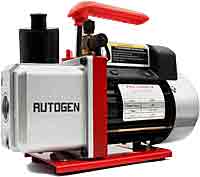
After you install the two section you need to add refrigerant to the tubing that runs between to two units. You will need to either find a professional that can do this for you or get some specialized equipment detailed in this YouTube® video.
This Poadotr, HVAC Vacuum Pump is used to suck the air out of the refrigerant lines before charging them with the gas. They also used a manifold gauge set, and a line flaring kit.
Many mini-split air conditioners need their lines charged but some, like the Pioneer at the top of the page, come pre-charged. The instructions detail the procedure to get the gas into the lines and the air out.
See this video YouTube® of a women who installed one of these in her campervan.
“More Power! We Need More Power, Mr. Scott!”
Most likely you are plugged into the 50 or 30 Amp outlet on your RV Park Pedestal. Air Conditioners use lots of amperage so you’ll want to take advantage of the additional 20 amp outlet on the pedestal too. Run a separate, heavy gauge, extension cord from the 20 amp outlet into your RV as dedicated air conditioner power.
Here is a great YouTube® video that explains it in detail.
Softstarts
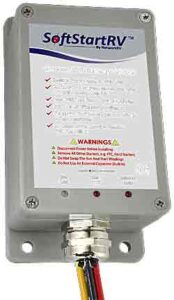
When an appliance first turns on there can be a large current draw and the circuits power up or mechanical parts like compressors of the air conditioner get going. These huge current draws can be hard on the rest of the electronics in your rig by causing low voltage situation and then voltage spikes.
SoftStartRV provides an effective solution in the reduction of startup current, typically up to 70%, but still provides full startup torque for compressors and motors.
A Softstart allows you to run two air conditioners on a 30 amp circuit without popping the circuit breaker. A Softstart device needs to be wired to each air conditioner. The company provides step-by-step phone consultation as you install it so you get it wired properly.
SoftStartUp
The SoftStartUp is basically the same device as the SoftStartRV but instead of installing it in each air conditioner you plug it in at the parks electrical pedestal. This save you from having to climb on the roof or hiring someone to do the installation. It can be used with your surge protector.
SoftStart products do not create more power, they optimize the power you have to end tripping circuit breakers. It includes all 30 and 50 amp adapters that might be needed.
SoftStart may not be compatible with all other devices in your RV. Air conditioners and dehumidifiers that use digital controls and certain types of brushless motors are not compatible with the SoftStart process. Variable speed, inverter air conditioners are not compatible.
More pages of the Tiny Life Consulting website you’ll be interested in
| How to clean and repair your existing roof top air conditioner |
Keeping Your RV Cool This Summer
Keeping Your Tiny Home Cooler in the Summer
All About Shore Power, Surge Protectors, 50 amp, 30 amp Hookups
Melted RV Shore Power Plug How to Avoid Tragedy
Generators or Portable Power Centers: Which One is Right for You?
Portable Inverter Generator Comparison
Running RV Appliances Like Air Conditioners Off-Grid




